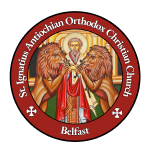Blessed Holy Saturday, brothers and sisters!
As we enter the final days of Holy Week, the sacred events intensify, and the border between them begins to blur. This is especially felt during the services of Holy Friday.
We began the day with the Royal Hours, where the Gospel readings recount the key moments of our Lord’s crucifixion. These were followed by the Great Vespers, during which we commemorated the taking down of Christ’s Body from the Cross and processed the Epitaphion – shroud bearing the image of His Body being prepared for burial – from the altar to the center of the church.

The day reaches its climax with the evening service: the Festal Orthros of Holy Saturday, celebrated by anticipation on Friday evening. At the heart of this service are the Lamentations, hymns arranged in tone and language as if from the perspective of the Mother of God, weeping before the burial of her Son. This Orthros closely resembles a funeral service. At its end, we process around the church with the Epitaphion in a symbolic burial procession.

Yet it is not all sorrow. Throughout this service, we hear hints of victory and resurrection:
- The irmos of the 9th Ode of the Canon proclaims:
“Mourn not for Me, O My Mother… for behold, I shall arise and shall be glorified.” - The Evlogitaria of the Resurrection follows the Lamentations almost immediately, pointing us already toward the dawn of life.
- And in the Old Testament reading after the procession, the Prophet Ezekiel declares:
“And you shall know that I am the Lord, when I open your graves, and raise you from your graves, O My people.”(Ezekiel 37:13)
This transition from death to life becomes even more clear on Holy Saturday morning, during the Vesperal Divine Liturgy. For the first time in Holy Week, we hear the Gospel account of the Resurrection (Matthew 28:1–20). Yet even as resurrection is proclaimed, Holy Saturday remains a quiet and contemplative day.
The hymn chanted in place of the Cherubic Hymn during the Great Entrance calls us into this sacred stillness:
“Let all mortal flesh keep silence and in fear and trembling stand, pondering nothing earthly-minded. For the King of kings and Lord of lords cometh forth to be slain and given as food to the faithful…”
On this day, our Lord rested in the flesh in the tomb, even as, in His divinity, He descended into Hades. There He preached the Gospel and led out all who believed in Him into Paradise. This is why all creation keeps silence: to contemplate the unfathomable love of God, who searched even in the depths of hell for His lost sheep.

On Friday evening, after the Lamentations service, our father and bishop, His Eminence, Metropolitan Silouan reflected about the meaning of these mysteries in a short homily. Through the Lamentations, the burial procession, and the Divine Liturgy of Holy Saturday, we are reminded of Christ’s boundless love. He descended even into Hell to call out to those in darkness, to offer them eternal life and resurrection
But the answer to that call for the mystical communion with God is for each and every one of us to make individually: Do we want to be with Christ? If so, we must show love and mercy, repent of our sins, and partake of the Holy Communion: the Body and Blood of Christ. He offered Himself so that we might live. It is hard to be saved outside the Church. The faith and the sacraments of the Church are gifts freely given. What remains is our response: our will to be with God, and to live according to His commandments.

“Behold the Sabbath transcendent in blessings in which Christ hath slept, and shall rise on the Third Day” (Kontakion from the Canon of the Holy Saturday)
A leave you with a beautiful English chanting of the Evlogitaria of Resurrection: https://www.youtube.com/watch?v=qWw3oQME9IE

